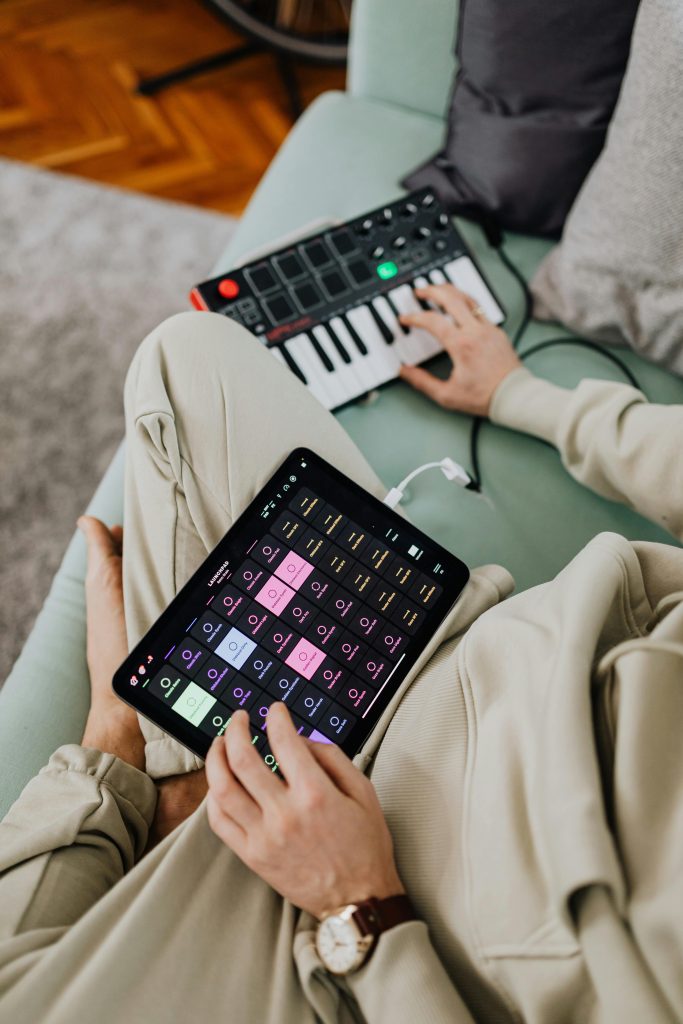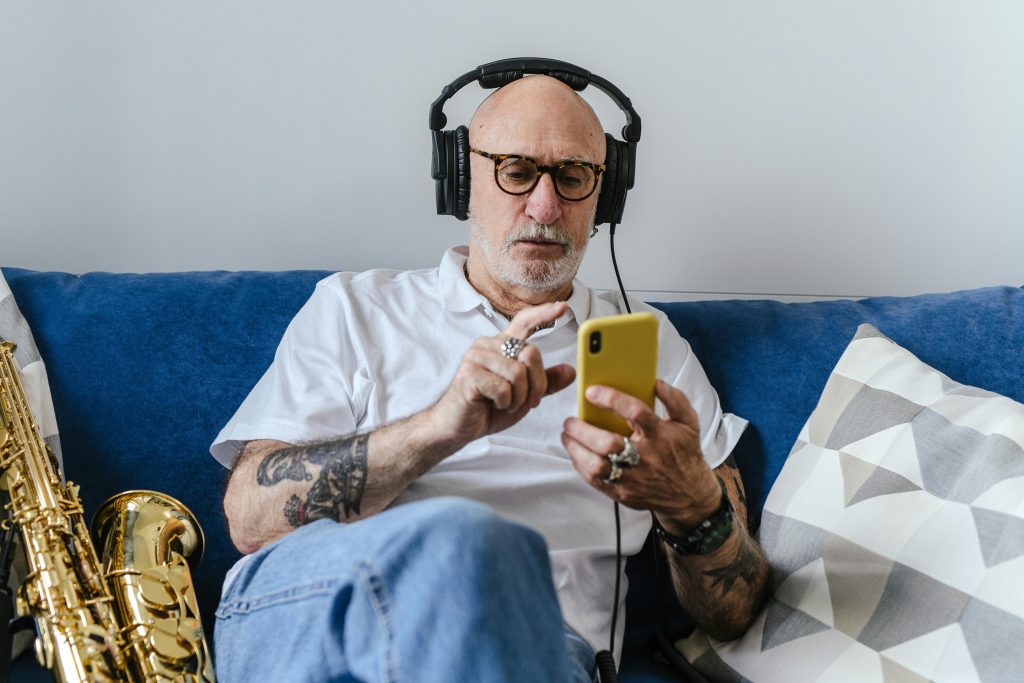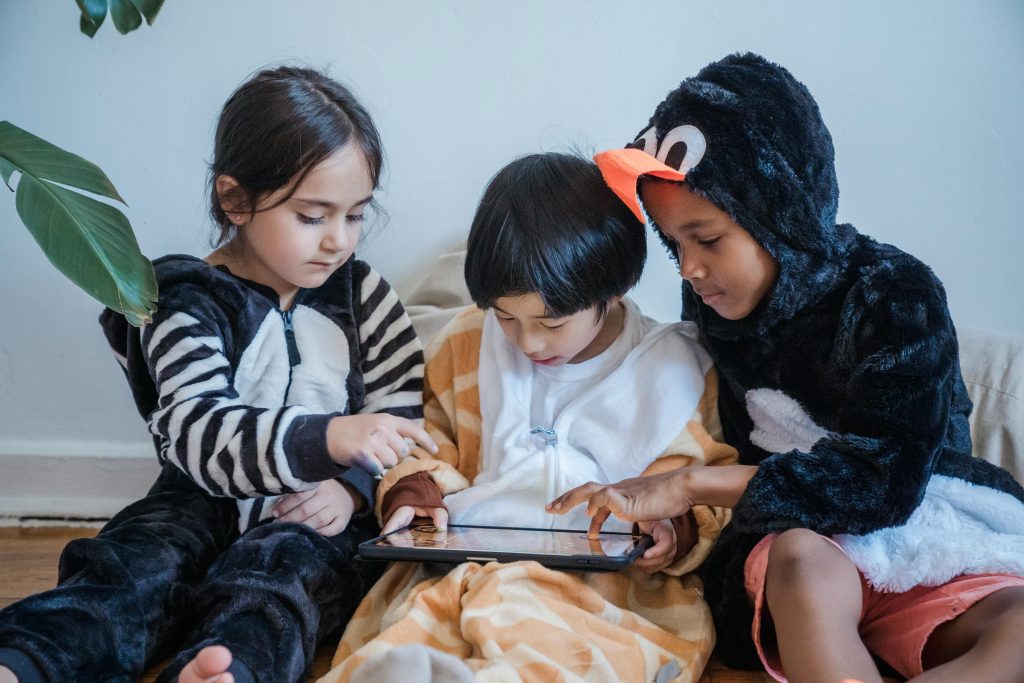Musicking in the Digital Age: New facets of Musical Practice
- Marie-Claude Mathieu, Doctoral student in music education, Laval University
- Jean-Philippe Després, Associate Professor Program Director, Master’s in Music – Music Education Program Director, Master’s in Music – Music Education (with Thesis) Program Director, Doctorate in Music – Music Education
- Andrea Creech, Professor in Schulich School of Music, McGill University
In our daily lives where technology is omnipresent, we are witnessing a new revolution that boldly shapes our interaction with music. The rapid development of music technologies has demystified the creation, interpretation, and appreciation of this art, eradicating the idea that they are reserved for an elite of musicians and music lovers. But what opportunities do these technologies truly offer us?
Music technology, a term that encompasses a variety of tools, from mobile devices to cutting-edge music production software, broadens our horizons by allowing us to discover, listen to, play, and even create music with unprecedented ease. The accessibility of these tools fuels creativity, dismantles some obstacles traditionally erected by music education, and, in a word, makes music more easily accessible to everyone.
Navigating the waves of this technological evolution in music, this article explores how these innovations disrupt and democratize our relationship with music, facilitate its access, and stimulate creativity at every turn of our existence.
Technologies and Musical Creativity

Listening, a universally practiced musical activity, has been transformed by the emergence of various digital audio formats such as MP3, WAV, or FLAC, and by the advent of streaming platforms such as YouTube, Spotify, and Apple Music. These advancements allow users not only to create playlists but also to share and publish their musical preferences online by selecting, cutting, or even merging works while customizing the order in which the tracks are played. This exploration and expression of musical choices, accessible to all, shapes the musical identity and preferences of listeners, especially teenagers for whom this activity is omnipresent (Crow, 2006). These playlists, akin to digital collages, invite their creators to sharpen their critical thinking and auditory skills, and to unleash their creativity by associating various musical elements such as timbre, rhythm, or style in sometimes unexpected ways (Kuhn et Hein, 2021).
However, musical composition is often perceived as inaccessible to the public, mainly due to a lack of theoretical knowledge and technical skills. This is where numerous software, platforms, and applications come into play, as they facilitate access to musical creation through intuitive approaches. Various games such as Incredibox, Pizza Groove et Chrome Music Lab and software like GarageBand, Logic Pro and BandLab offer user-friendly interfaces, allowing “music-makers” to compose using pre-recorded sounds, rearrange (remix) elements of existing pieces, or even use virtual instruments and USB microphones to record their own voice. Thus, this layered approach to musical creation, which allows for editing various aspects of music and playing it at almost any tempo, offers users the chance to compose music that they might not necessarily be able to play with acoustic instruments.
As for improvisation, this instantaneous expression of musical ideas is often perceived as the domain of insiders. Moreover, in the school context, few teachers venture to integrate it into their curriculum, as they themselves have not learned to improvise. Fortunately, some software, applications, and websites prove invaluable for exploring this form of expression. A notable example is the tool Improvison, a collaborative game, as well as Band-in-a-Box, which generates sound accompaniments played by a complete virtual orchestra, thus democratizing access to improvisation.
Technology and Musical Creativity: a Stimulating Practice Promoting Well-being

Technology-assisted musical practice reveals a panorama of benefits, notably by catalyzing motivation and well-being, especially among vulnerable populations. In the school setting, these technologies can open new musical avenues for young people who would not naturally engage in traditional musical paths. At the same time, they prove to be valuable tools for enriching the lives of the elderly.
At the secondary level, music programs sometimes struggle to capture the interest of a wide range of students, and the creative activities offered do not always immerse them in deep and meaningful musical experiences. Furthermore, teacher-centered pedagogy – as exemplified by the conductor leading an ensemble – can hinder motivation, whereas many students aspire to produce their own music in a more autonomous context. Technologies can then enrich and diversify learning experiences by facilitating a project-based approach, where students have more latitude to define their learning objectives and musical aspirations. Whether it’s song composition, rhythm programming, instrumental playing, recording, or sound editing and mixing, musical learning occurs through practice and sound exploration, at a pace adapted to the needs and interests of each learner. Moreover, some software and applications for musical creation bring young people closer to the sounds of popular music they usually listen to, thus creating a bridge between the music studied at school and the music that accompanies their daily lives (Cain,2004).
For the elderly, engaging in music through technology can become a substantial source of well-being. Participation in activities such as listening, interpretation (such as singing), or creation has the potential to improve mood, strengthen social ties, facilitate communication, and encourage both physical and emotional expression. It has also been shown that technology can promote well-being by acting as instruments of reminiscence and reflection. Musical sharing rituals offer a means for seniors to revisit their past, share memories with their loved ones, and positively integrate their lived experiences. Finally, technology can also serve as a tool offering new opportunities for learning and musical development in older adults, while mitigating the obstacles often encountered with traditional acoustic instruments (Laes et Creech, 2023).
Accessibility and Diversity of Musical Practices in the Digital Age
The era of digital audio production has transformed the musical landscape, catapulting its accessibility to unprecedented heights. Music production software such as Pro Tools, Ableton Live, Logic Pro and GarageBand not only are available at relatively affordable or even free prices but also offer sound quality that rivals that of professionals. Thanks to the user-friendly nature of these tools, even novices and beginners can dive into the world of music production, a terrain once reserved for sound engineers (Park, 2017).

Current technologies also promote inclusion by making musical activities accessible to people with specific needs or physical limitations. Thus, a person unable to manipulate a keyboard or mouse can play and create music with devices operated by sensors such as the Soudbeam or Skoog. In a music class, this means that every student, without exception, has the opportunity to engage actively and experience success with these adaptive instruments. For adults living with a cochlear implant, the computerized rehabilitation program HearTunes (Rehab) not only improves their auditory perception but also enriches their understanding of speech by offering them a pleasurable musical listening experience (Smith et al., 2017).
The accessibility offered by these technologies also resonates particularly with the elderly, including those experiencing cognitive impairments, who manage to learn how to use these tools (Creech, 2019). A study using technological tools demonstrated that individuals moderately affected by Alzheimer’s disease were able to select their favorite musical pieces and trigger them autonomously (Lancioni et al., 2014). Other researchers have adapted the iPad application SingFit,, which served as a trigger, allowing previously musically inactive seniors to learn or relearn to sing regularly (Reid, 2017). At a stage in life where cognitive and motor decline may occur, musical technologies open up captivating new avenues.
Technology and Musical Collaboration

Musical technologies provide a conducive framework for musical practice that transcends the opportunities offered in formal educational environments, placing notable emphasis on collaboration. Whether online or within dedicated physical collaboration spaces, an increasing number of learners turn to these communities to learn, create, play, or share their musical passions. These socially-focused learning environments can be highly beneficial in encouraging budding “music-makers” to explore new types of musical learning, opening doors they may not have discovered on their own (Peppler, 2017). Indeed, sharing knowledge and mutual encouragement increase the chances of learning to use new tools, persevering, and overcoming challenges and difficulties more easily.
Some innovative and promising initiatives support the social learning of music by providing young people with recording studios where they can record and mix their own music. In these spaces, young people learn through observation and interaction with their peers. A palpable example of these informal communities is YOUmedia, an expanding network comprising over 30 public libraries, museums, and community organizations across the United States. The concept is to let young people have fun and explore through hands-on activities while developing critical thinking, creativity, and digital media skills.
In conclusion, the evolution of musical technologies has transformed how music is produced, listened to, and disseminated. Thanks to their accessibility, these technologies stimulate exploration, creation, and musical interpretation among a wider audience, without excluding individuals with special needs. Whatever the goals, musical technologies offer a powerful potential for expression and creativity that can contribute to the overall well-being of “music-makers” of all ages.
Also Worth Noting
Musical technologies are a great way to introduce young children to music. By offering exploratory and interactive games, children can interact with music and exercise their creativity.
Instead of playing a passive role, like that of an audience member in a concert hall, learning music through technology puts the learner in the driver’s seat of their learning. From the first steps, the user is immediately immersed in action regardless of the goal.
Being able to practice autonomously is also among the advantages of engaging in music using technology. Karaoke, one of the most popular pastimes in Japan, is a good example of an activity that can be practiced at home without the help of a teacher or facilitator.
Our Advice
- Start your exploration with creative games that allow for almost instant creation.
- Begin with free tools and platforms that include pre-recorded sounds (loops) ready to be arranged.
- Take advantage of technology-assisted learning to understand how platforms and software offered in the market work.
- Technologies often integrate learning resources such as interactive tutorials, online lessons, and AI-assisted tools to help users develop their musical skills.
- Accompany children in their musical activities.
- Seek information from various stakeholders to access instruments adapted for your loved ones with special needs.
- Experiment with sharing and listening to music with your loved ones experiencing cognitive decline by starting with their favorite repertoire.
References
- Crow, B. (2006). Musical Creativity and the New Technology Music Education Research, 8(1), 121‑130.
- Kuhn, W., et Hein, E. (2021). Electronic Music School : A Contemporary Approach to Teaching Musical Creativity. Oxford University Press. https://doi.org/10.1093/oso/9780190076634.001.0001
- Cain, T. (2004). Theory, Technology and the Music Curriculum. British Journal of Music Education, 21(2), 215‑221.
- Ellis, P. (2004). Vibroacoustic sound therapy : Case studies with children with profound and multiple learning difficulties and the elderly in long-term residential care. Studies in health technology and informatics, 103, 36‑42.
- Duffey, T., Somody, C., et Clifford, S. (2008). Conversations with My Father. Journal of Creativity in Mental Health, 2(4), 45‑63. Taylor and Francis Journals. https://doi.org/10.1300/J456v02n04_05
- Park, T. H. (2017). Instrument technology : Bones, Tones, Phones and Beyond. Dans A. King, E. Himonides, et A. Ruthmann (Éds.), The Routledge companion to music, technology, and education. Routledge; https://doi.org/10.4324/9781315686431
- Smith, L., Bartel, L., Joglekar, S., et Chen, J. (2017). Musical Rehabilitation in Adult Cochlear Implant Recipients With a Self-administered Software. Otology & Neurotology, 38(8). https://journals.lww.com/otology-neurotology/fulltext/2017/09000/musical_rehabilitation_in_adult_cochlear_implant.36.asp
- Creech A. (2019). Using Music Technology Creatively to Enrich Later-Life: A Literature Review. Frontiers in psychology, 10, 117. https://doi.org/10.3389/fpsyg.2019.00117
- Lancioni, G. E., Singh, N. N., O’Reilly, M. F., Sigafoos, J., Renna, C., Pinto, K., De Vanna, F., Caffò, A. O., et Stasolla, F. (2014). Persons with moderate Alzheimer’s disease use simple technology aids to manage daily activities and leisure occupation. Research in Developmental Disabilities, 35(9), 2117‑2128. https://doi.org/10.1016/j.ridd.2014.05.002
- Reid, A. G., Rakhilin, M., Patel, A. D., Urry, H. L., Thomas, A. K., et Society for Music Perception and Cognition Vanderbilt University, U. A. 2015. (2017). New technology for studying the impact of regular singing and song learning on cognitive function in older adults : A feasibility study. Psychomusicology: Music, Mind, and Brain, 27(2), 132‑144.
- Peppler, K. (2017). Equity and Access in Out-of-School Music Making. Dans A. Ruthmann et R. Mantie (Éds.), The Oxford handbook of technology and music education. Oxford University Press.
- Laes, T., & Creech, A. (2023). Re-conceptualizing music education in the older adult life course: A qualitative meta-synthesis. 0(0). doi:10.36922/ijps.383